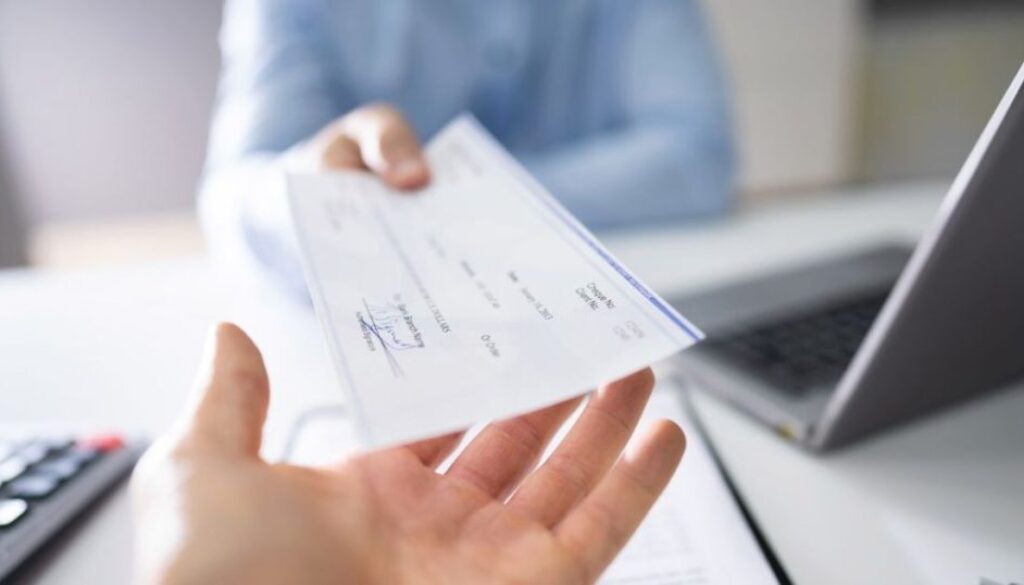How to Endorse a Check to Someone Else in 4 Steps
[ad_1]
How to Endorse a Check to Someone Else in 4 Steps
If you owe someone, you most likely want to pay them as soon as you can. With digital banking adding your paychecks right to your bank account, you may not always have cash on you. You may also have some checks lying around that you’ve put off depositing.
To save time, you could endorse a check to someone else to pay them. This means that you sign over a check to them that was originally given to you, and they deposit it instead. We go over the four main steps for how to endorse a check to someone else below.

Step 1: Create a Plan With Your Recipient
Endorsing a check to someone else isn’t always an option, but you may be able to use this method for rent or other monthly expenses. First, talk to your recipient to ensure they’re comfortable with this payment option.
- Product on sale
 QuickBooks Online SubscriptionFrom: $27.00 / month
QuickBooks Online SubscriptionFrom: $27.00 / month
Recipients may worry about banks denying this payment, even though this may not be common. To avoid endorsing a check to someone that may not accept it, make sure you communicate beforehand. If they’re on board, exchange your full name and contact information for the next few steps.
Step 2: Double-Check With Your Bank
It’s common for banks to have different rules and requirements when it comes to endorsing a check to someone else. Given the risk of stolen checks or checks paid to the wrong person, some banks may not offer these services. To make this process smooth, call or visit your bank first.
- Product on sale
 Online Cloud Accounting ServicesOriginal price was: $500.00.$250.00Current price is: $250.00.
Online Cloud Accounting ServicesOriginal price was: $500.00.$250.00Current price is: $250.00.
Keep in mind you may need to contact the bank you initially received the check from. In most cases, you can find the bank’s contact information on the front of the check. When you reach out, don’t forget to ask about any extra identification your recipient may need to bring with them to cash it out.

Step 3: Correctly Sign the Check Over to the Recipient
Now, how do you sign over a check to someone else? Start by flipping the check over to find the endorsement line. This is normally located on the right or left along the height of the check reading “endorse check here.”
Once you’ve found it, sign your name on the top line, then write out “Pay to the order of [recipient name]” underneath. This shows the teller that you authorize this check to be paid to a third party. Be sure to write out your recipient’s name as it appears on their I.D. — the teller will double-check their identification before cashing it out.
Step 4: Hand Over Your Check
It’s time to hand over the payment to your recipient! When you’re meeting up with your recipient, exchange contacts if you haven’t already. If any mishaps were to happen, like the bank not accepting the payment, they’ll be able to contact you.
If you get worried, touch base with your recipient to ensure the check went through. If you or anyone else in the exchange feels uneasy, opt for a more secure alternative. For instance, certified checks are authorized by banks for a more secure payment method and may be a better payment alternative, especially for large purchases.
Two Alternatives to Signing a Check For Someone Else

Paying bills with checks you already have may save you time, but not always for the recipient. When an endorsed check isn’t a comfortable option, there are a few different routes to go down instead.
1. Cash Out at the Issued Bank
You could simply go to the bank and cash out your check. Most banking apps nowadays allow digital check deposits and online transfers. You can run to your local ATM to cash out the money, or transfer money online. To do this, use your bank’s mobile app or other apps like Venmo or Cashapp.
Keep in mind, most ATMs or banks that aren’t associated with your bank may charge service fees. While this usually costs only a few dollars, that could buy you your morning coffee.
2. Open a Bank Account
If you don’t already have a bank account, it may be time to open one! Frequently cashing in checks at banks you don’t have an account with can rack up a hefty bill. If you were to cash in your bi-weekly paychecks with a $5 service fee, that would cost you $120 a year in fees. That’s $120 you could be putting towards your savings for future investments.
Having a bank account may also help make payments easier and streamlined. Automating payments may help you avoid late fees and track your monthly spending. Using apps like Mint, you can keep track of your money going in and out via your trusty smartphone.
When checks are filled out to you, you may feel like you’re the only one that’s able to do anything with it. For times you don’t feel like cashing in your check, you can endorse it to someone you may need to pay. While this is doable, you may want to take the extra steps to make this as smooth as can be. To do this, use our steps above and check on your budget before making any financial decisions using our app.
Related
[ad_2]
Source link





You must be logged in to post a comment.